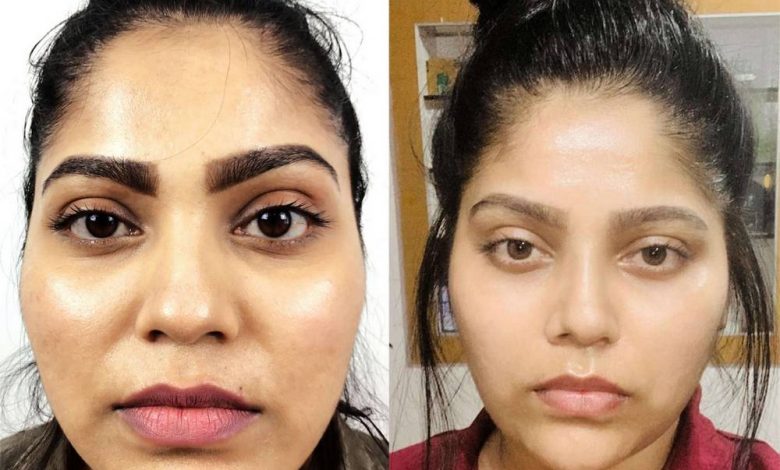Wide nose bridge, hypertelorism: what is this, causes, symptoms, diagnostics, treatment, prevention

Broad nasal bridge
A wide bridge of the nose is a characteristic feature of the face of people with a wide flat nose.. It can be found in both sexes and all ethnic groups.. The bridge of the nose is usually the area of the nose from the eyebrows to the tip of the nose.. People with a wide nose bridge may be embarrassed by the appearance of their nose and seek treatments., to improve the look.
What is a wide bridge?
Wide bridge of the nose is a medical term, denoting a wide and flat nose. Medically this is called hypertelorism.. A wide bridge of the nose is present in a person from birth or develops in childhood. It affects the area of the nose from the eyebrows to the tip of the nose and is often referred to as the bridge of the nose.. People with a wide bridge of nose seem to have a wider nose, than usual, and have a flatter bridge.
Causes of a wide nose bridge
The most common cause of a wide nose bridge is genetics.. It is inherited from parents and can affect both sexes.. Other causes of a wide nose bridge can be medical conditions, such as Down's syndrome, as well as certain environmental factors, such as exposure to environmental pollutants or radiation.
Symptoms of a wide bridge of the nose
People with a wide bridge often have wide and flat noses.. They may also have thick nasal passages and a wide nasal tip.. People with a wide bridge of the nose are often embarrassed by the appearance of their nose..
When to contact a healthcare professional
No need to see a doctor, if you have a wide bridge of the nose. But, if you are concerned about the appearance of your nose, you can talk to a doctor or plastic surgeon. They can discuss various treatments, to help improve the appearance of your nose.
Questions, that your doctor may ask
When you visit a doctor or plastic surgeon, to discuss treatment options for a wide nose bridge, they may ask you some questions. These questions may include:
- How long have you had this disease?
- Does anyone else in your family have this condition??
- Are you looking for a cosmetic or medical treatment??
- What is your budget for treatment?
- Do you have any allergies or diseases, which may affect treatment?
Diagnosis of a wide bridge of the nose
A doctor or plastic surgeon will be able to diagnose a wide bridge of the nose, looking at the patient's nose. They may also order x-rays or other tests., to take a closer look at the structure of the nose.
Treatment of a wide bridge of the nose
The most common treatment for a wide bridge of the nose is rhinoplasty..
Rhinoplasty is a surgical procedure, which changes the shape of the nose, making it more proportional to the rest of the face. It can also be used, to reduce the width of the nose and make the bridge of the nose less visible.
Other treatments for a wide nose bridge include non-surgical treatments, such as fillers, laser treatment and other injectable treatments.
Home treatment for a wide bridge of the nose
People with a wide nose bridge can also try home treatments., to help improve the appearance of the nose. Using a humidifier in the bedroom will help keep the air moist and reduce dry nasal passages.. Applying a warm compress to the nose can also be helpful., as it can help reduce swelling and open nasal passages.
Prevention of a wide bridge of the nose
Wide nose bridge is a genetic disease and cannot be prevented. Nonetheless, people may reduce their risk of developing a wide nose bridge, avoiding environmental pollutants and radiation, as well as avoiding certain medications during pregnancy.
Conclusion
A wide bridge of the nose is a characteristic feature of the face of people with a wide flat nose.. It's caused by genetics, diseases and environmental factors.
People with a wide nose bridge may be embarrassed about their appearance., and there are treatment options, to help improve the appearance of the nose.
Home treatment and avoidance of environmental pollutants and radiation can also help reduce the risk of developing a wide nose bridge..
Used sources and literature
Chambers C, Friedman JM. Teratogenesis and environmental exposure. In: Real R, Lockwood CJ, Moore TR, Greene MF, Copel JA, Silver RM, eds. Creasy and Resnik’s Maternal-Fetal Medicine: Principles and Practice. 8th ed. Philadelphia, PA: Elsevier; 2019:chap 33.
Haddad J, Dodhia SN. Congenital disorders of the nose. In: Kliegman RM, St. Geme JW, Bloom NJ, Shah SS, Tasker RC, Wilson KM, eds. Nelson Textbook of Pediatrics. 21st ed. Philadelphia, PA: Elsevier; 2020:chap 404.
Olitsky SE, Marsh JD. Disorders of eye movement and alignment. In: Kliegman RM, St. Geme JW, Bloom NJ, Shah SS, Tasker RC, Wilson KM, eds. Nelson Textbook of Pediatrics. 21st ed. Philadelphia, PA: Elsevier; 2020:chap 641.
